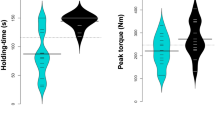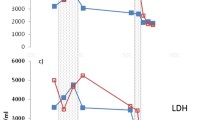Abstract
Work-related neck/shoulder muscle pain has been associated with increased anaerobic muscle metabolism. Thus, interventions to enhance oxygenation of painful muscles seem relevant. While cycling with relaxed shoulders has been shown to result in acute neck/shoulder muscle pain reduction, the effect on tissue oxygenation remains unknown. The aim of the present study was to investigate tissue oxygenation of the passive trapezius muscle during and after cycling in female workers with (MYA) and without (CON) trapezius myalgia. Eligible participants (n = 17 MYA, n = 8 CON) performed 20 min sub-maximal cycling in an upright position with relaxed shoulders. Near-infrared spectroscopy was used to measure trapezius muscle oxygenation during and 2 min after the cycling period. For both MYA and CON, oxygenation of the passive trapezius increased in a linear fashion over time, to values ~5 μM above baseline at the end of the cycling period, with no significant group difference (CON 5.2, MYA 4.9 μM). Two min after termination of exercise, oxygenation was increased further in both groups, but significantly more in CON (8.8 μM) than in MYA (7.0 μM) (P = 0.05). In conclusion, cycling increases oxygenation of resting neck/shoulder muscles in women with and without trapezius myalgia, indicating acute positive effects of either neural or humoral factors on vascular beds of distant relaxed muscles. Although this beneficial response was observed in both groups, the post-exercise response was lower in women with trapezius myalgia.

Similar content being viewed by others
References
Andersen LL, Kjaer M, Søgaard K, Hansen L, Kryger AI, Sjøgaard G (2008a) Effect of two contrasting types of physical exercise on chronic neck muscle pain. Arthritis Rheum 59(1):84–91
Andersen LL, Suetta C, Andersen JL, Kjær M, Sjøgaard G (2008b) Increased proportion of megafibers in chronically painful muscles. Pain 139(3):588–593
Åstrand I (1960) Aerobic work capacity in men and women with special reference to age. Acta Physiol Scand Suppl 169:1–92
Bangsbo J, Aagaard T, Olsen M, Kiens B, Turcotte LP, Richter EA (1995) Lactate and H+ uptake in inactive muscles during intense exercise in man. J Physiol 488(Pt 1):219–229
Belardinelli R, Barstow TJ, Porszasz J, Wasserman K (1995) Changes in skeletal muscle oxygenation during incremental exercise measured with near infrared spectroscopy. Eur J Appl Physiol 70(6):487–492
Blangsted AK, Søgaard K, Hansen EA, Hannerz H, Sjøgaard G (2008) One-year randomized controlled trial with different physical-activity programs to reduce musculoskeletal symptoms in the neck and shoulders among office workers. Scand J Work Environ Health 34(1):55–65
Chance B, Dait MT, Zhang C, Hamaoka T, Hagerman F (1992) Recovery from exercise-induced desaturation in the quadriceps muscles of elite competitive rowers. Am J Physiol 262(3 Pt 1):C766–C775
de Geus B, Van HE, Aerts I, Meeusen R (2008) Cycling to work: influence on indexes of health in untrained men and women in Flanders. Coronary heart disease and quality of life. Scand J Med Sci Sports 18(4):498–510
DeSouza CA, Shapiro LF, Clevenger CM, Dinenno FA, Monahan KD, Tanaka H, Seals DR (2000) Regular aerobic exercise prevents and restores age-related declines in endothelium-dependent vasodilation in healthy men. Circulation 102(12):1351–1357
Fadel PJ, Keller DM, Watanabe H, Raven PB, Thomas GD (2004) Noninvasive assessment of sympathetic vasoconstriction in human and rodent skeletal muscle using near-infrared spectroscopy and Doppler ultrasound. J Appl Physiol 96(4):1323–1330
Goldfarb AH, Hatfield BD, Armstrong D, Potts J (1990) Plasma beta-endorphin concentration: response to intensity and duration of exercise. Med Sci Sports Exerc 22(2):241–244
Goto C, Nishioka K, Umemura T, Jitsuiki D, Sakagutchi A, Kawamura M, Chayama K, Yoshizumi M, Higashi Y (2007) Acute moderate-intensity exercise induces vasodilation through an increase in nitric oxide bioavailability in humans. Am J Hypertens 20(8):825–830
Green D, Cheetham C, Mavaddat L, Watts K, Best M, Taylor R, O’Driscoll G (2002) Effect of lower limb exercise on forearm vascular function: contribution of nitric oxide. Am J Physiol Heart Circ Physiol 283(3):H899–H907
Green DJ, Bilsborough W, Naylor LH, Reed C, Wright J, O’Driscoll G, Walsh JH (2005) Comparison of forearm blood flow responses to incremental handgrip and cycle ergometer exercise: relative contribution of nitric oxide. J Physiol 562(2):617–628
Hamer M, Chida Y (2008) Active commuting and cardiovascular risk: a meta-analytic review. Prev Med 46(1):9–13
Juul-Kristensen B, Kadefors R, Hansen K, Bystrom P, Sandsjo L, Sjøgaard G (2006) Clinical signs and physical function in neck and upper extremities among elderly female computer users: the NEW study. Eur J Appl Physiol 96(2):136–145
Kaergaard A, Andersen JH, Rasmussen K, Mikkelsen S (2000) Identification of neck-shoulder disorders in a 1 year follow-up study. Validation of a questionnaire-based method. Pain 86(3):305–310
Kryger AI, Andersen JH, Lassen CF, Brandt LP, Vilstrup I, Overgaard E, Thomsen JF, Mikkelsen S (2003) Does computer use pose an occupational hazard for forearm pain; from the NUDATA study. Occup Environ Med 60(11):e14
Kuorinka I, Jonsson B, Kilbom Å, Vinterberg H, Biering-Sørensen F, Andersson G, Jørgensen K (1987) Standardised Nordic questionnaires for the analysis of musculoskeletal symptoms. Appl Ergon 18(3):233–237
Larsson R, Oberg PA, Larsson SE (1999) Changes of trapezius muscle blood flow and electromyography in chronic neck pain due to trapezius myalgia. Pain 79(1):45–50
Larsson B, Bjork J, Kadi F, Lindman R, Gerdle B (2004) Blood supply and oxidative metabolism in muscle biopsies of female cleaners with and without myalgia. Clin J Pain 20(6):440–446
Larsson B, Søgaard K, Rosendal L (2007) Work related neck-shoulder pain: a review on magnitude, risk factors, biochemical characteristics, clinical picture and preventive interventions. Best Pract Res Clin Rheumatol 21(3):447–463
McAllister RM (1998) Adaptations in control of blood flow with training: splanchnic and renal blood flows. Med Sci Sports Exerc 30(3):375–381
Ohlsson K, Attewell RG, Johnsson B, Ahlm A, Skerfving S (1994) An assessment of neck and upper extremity disorders by questionnaire and clinical examination. Ergonomics 37(5):891–897
Pedersen BK, Saltin B (2006) Evidence for prescribing exercise as therapy in chronic disease. Scand J Med Sci Sports 16(Suppl 1):3–63
Perko MJ, Nielsen HB, Skak C, Clemmesen JO, Schroeder TV, Secher NH (1998) Mesenteric, coeliac and splanchnic blood flow in humans during exercise. J Physiol 513(Pt 3):907–913
Rosendal L, Blangsted AK, Kristiansen J, Søgaard K, Langberg H, Sjøgaard G, Kjaer M (2004a) Interstitial muscle lactate, pyruvate and potassium dynamics in the trapezius muscle during repetitive low-force arm movements, measured with microdialysis. Acta Physiol Scand 182(4):379–388
Rosendal L, Larsson B, Kristiansen J, Peolsson M, Søgaard K, Kjaer M, Sorensen J, Gerdle B (2004b) Increase in muscle nociceptive substances and anaerobic metabolism in patients with trapezius myalgia: microdialysis in rest and during exercise. Pain 112(3):324–334
Saito M, Mano T, Iwase S (1990) Changes in muscle sympathetic nerve activity and calf blood flow during static handgrip exercise. Eur J Appl Physiol Occup Physiol 60(4):277–281
Schutte AE, Huisman HW, van Rooyen JM, Malan NT, Schutte R (2004) Validation of the Finometer device for measurement of blood pressure in black women. J Hum Hypertens 18(2):79–84
Silber D, McLaughlin D, Sinoway L (1991) Leg exercise conditioning increases peak forearm blood flow. J Appl Physiol 71(4):1568–1573
Sjøgaard G (1982) Capillary supply and cross-sectional area of slow and fast twitch muscle fibres in man. Histochemistry 76:547–555
Sjøgaard G, Rosendal L, Kristiansen J, Blangsted AK, Skotte J, Larsson B, Gerdle B, Saltin B, Søgaard K (2010) Muscle oxygenation and glycolysis in females with trapezius myalgia during stress and repetitive work using microdialysis and NIRS. Eur J Appl Physiol 108(4):657–669
Sjøgaard G, Jensen BR, Hargens AR, Søgaard K (2004) Intramuscular pressure and EMG relate during static contractions but dissociate with movement and fatigue. J Appl Physiol 96:1522–1529
Tanaka H, Shimizu S, Ohmori F, Muraoka Y, Kumagai M, Yoshizawa M, Kagaya A (2006) Increases in blood flow and shear stress to nonworking limbs during incremental exercise. Med Sci Sports Exerc 38(1):81–85
van Beekvelt MC (2002) Quantitative near-infrared spectroscopy in human skeletal muscle: methodological issues and clinical application (Ref Type: Thesis/Dissertation)
Von Korff M, Ormel J, Keefe FJ, Dworkin SF (1992) Grading the severity of chronic pain. Pain 50(2):133–149
Vuori IM, Oja P, Paronen O (1994) Physically active commuting to work–testing its potential for exercise promotion. Med Sci Sports Exerc 26(7):844–850
Ylinen J, Takala EP, Nykanen M, Hakkinen A, Malkia E, Pohjolainen T, Karppi SL, Kautiainen H, Airaksinen O (2003) Active neck muscle training in the treatment of chronic neck pain in women: a randomized controlled trial. JAMA 289(19):2509–2516
Acknowledgments
Henrik Baare Olsen is acknowledged for technical assistance. This study was supported by grants from the Danish Medical Research Council 22-03-0264 and the Danish Rheumatism Association 233-1149-02.02.04.
Author information
Authors and Affiliations
Corresponding author
Additional information
Communicated by Fausto Baldissera.
Rights and permissions
About this article
Cite this article
Andersen, L.L., Blangsted, A.K., Nielsen, P.K. et al. Effect of cycling on oxygenation of relaxed neck/shoulder muscles in women with and without chronic pain. Eur J Appl Physiol 110, 389–394 (2010). https://doi.org/10.1007/s00421-010-1517-4
Accepted:
Published:
Issue Date:
DOI: https://doi.org/10.1007/s00421-010-1517-4




